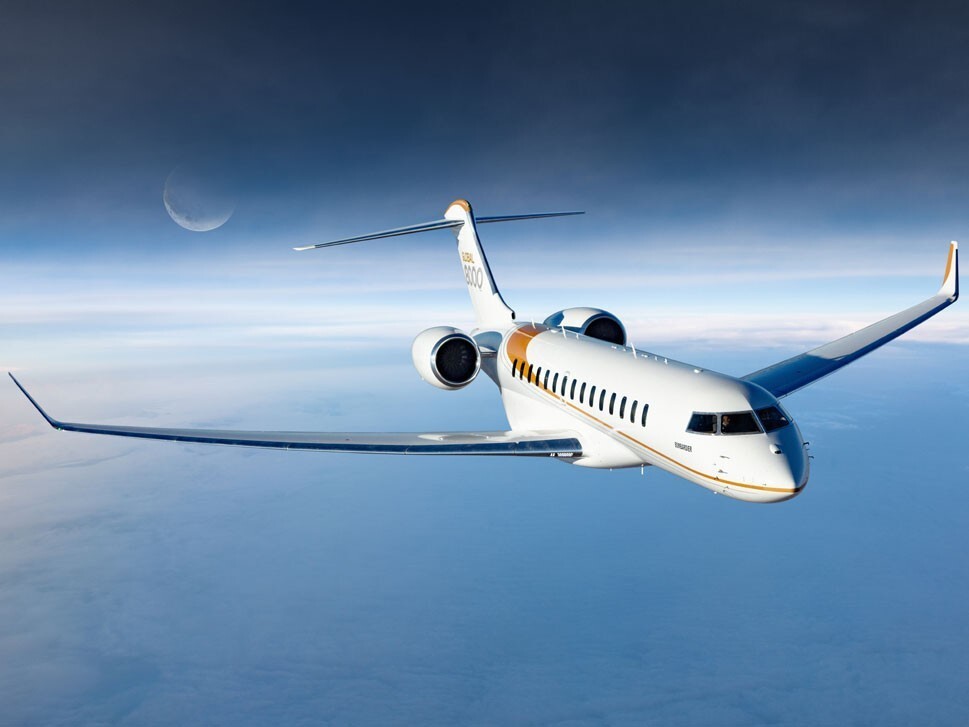- 04 Oct 2021
- Matt Harris
- New Private Jets
Bombardier Global 8000: Did the Market Need More Range?
Following the launch of the Bombardier Global 8000, the upper limits of non-stop business jet travel inched further forward. But is another Ultra-Long-Range Jet really what the industry needs? René Armas Maes explores…
Back to Articles
Launched as an upgraded version of its existing Bombardier Global 7500, the Global 8000 offers greater range and high-cruise speed than any other purpose-built private jet in production or in development. Bombardier made a firm statement to the industry in its ongoing wrestle with Dassault and Gulfstream at the very top end of the market.
As Bombardier said during the unveiling in May, the new Global 8000 is “two aircraft in one”, providing everything the Global 7500 has to offer but with a level of performance that has “never been seen before” in Business Aviation. In addition to the 8,000nm range, the jet will feature a top speed of Mach 0.94, powered by a pair of GE Passport engines.
Bombardier was quick to reassure existing Global 7500 operators that they will be able to retrofit their aircraft to bring Global 8000 performance to their jets.
Initially, the Global 8000 was intended to be a shorter, three-zone aircraft. However, Bombardier chose to bide their time, waiting for Gulfstream to make the next move with its G800 before making a final decision on its future flagship aircraft. The result was to produce a longer-range version of the Global 7500 with an additional cabin zone to battle the G800 for market share.
Based on market research, Bombardier believes that while range is one of the top deciding factors for business jet buyers, another key area is cabin comfort, followed by top speed. Thus, while much of the Global 8000 launch coverage focused on nudging the range boundaries that little bit further, Bombardier has actually captured all three key deciding factors in its newest jet.
Ultra-Long-Range Market Opportunity?
The top tiers of the Business Aviation segment can be divided into Long Range Jets (those with ranges between 5,000nm and 5,999nm), and Ultra-Long-Range Jets (those with ranges of 6,000 nautical miles or more). Three OEMs compete in the Ultra-Long-Range segment today:
- Bombardier: Global 6000, Global 6500, Global 7500, and Global 8000 (scheduled service entry in 2025).
- Dassault Falcon: Falcon 8X, and Falcon 10X (scheduled service entry in 2025 or later)
- Gulfstream Aerospace: G600, G650/ER, G700, and G800 (scheduled service entry in 2023 or later). Gulfstream delivered its final G550 in 2021.
According to AMSTAT data, and factoring the normal pre-pandemic business aircraft deliveries of 2016 and 2017, Bombardier, Dassault and Gulfstream shipped 275 factory new Ultra-Long-Range jets between them, or 137.5 aircraft annually. In 2018 and 2019, that increased slightly to 280 (or 140 aircraft per year).
For the pandemic years of 2020 and 2021, the three OEMs again delivered 280 Ultra-Long-Range jets between them.
Looking at Ultra-Long-Range market share between 2016 and 2021, Gulfstream enjoyed the upper hand, with 57% of the units delivered, followed by Bombardier (34%) and Dassault Falcon (9%). But more recently – between 2020 and 2021 – Gulfstream’s market share shrunk 6% to 51%. Bombardier was the OEM to gain, seeing its market share increase to 41%.
Specifically, the 100+ Bombardier Global 7500 deliveries helped Bombardier to a larger slice of the ‘pie’. The 140 aircraft delivered annually in the Ultra-Long-Range Jet market can be estimated to be worth between $9.2bn and $9.5bn in 2021 – so there’s clearly much to play for with all three OEMs.
With aftermarket services factored in, that total would likely exceed $10bn. Having made gains on Gulfstream with the Global 7500, it’s logical that Bombardier would fight hard to exceed the range and speed boundaries, yet again, with the Global 8000.
As the Global 8000, Falcon 10X and G800 join the marketplace from 2023 and beyond, we can expect the top-end market value to increase by at least an additional $1.1bn, based on the new aircrafts’ higher price tags (currently between $75m and $78m).
UHNWI Market: Shrinking or Growing?
One key question arises for the OEMs as they focus on sales expansion within this market segment. Is the affluent Ultra-High-Net-Worth Individual (UHNWI) segment shrinking or growing globally?
According to the Wealth Report 2021, lower interest rates and greater fiscal stimuli have increased the world’s UHNWI population by 2.4% compared to 2020. This has occurred across North America, Europe, and Asia. Indeed, by 2025 the population of UHNWI is expected to grow 27%.
With an increasing UHNWI population, the next question is what percentage of the UHNWI population has been exposed to Business Aviation already, and how many are already business jet owners?
Based on Jetcraft’s Five-Year Pre-Owned Market Forecast (2021-2025), 10% of UHNWIs use private aviation solutions other than full aircraft ownership (i.e., jet cards, fractional ownership, and ad-hoc charter) as a primary travel solution, while only 2% actually own a private jet.
Conclusion
With the expected growth in the UHNWI population, coupled with the current low Business Aviation penetration, the potential for the Ultra-Long-Range Jet market is clear. A key opportunity exists to expand and capture greater market share, and the OEMs must aggressively pursue this high-margin opportunity – as is being borne out with the launch of the Global 8000.
While targeting potential new UHNWI Business Aviation users, the OEMs will be focusing their efforts on North America, Europe and Asia (as indicated in Table A) over the coming years.
The final question is how Dassault will respond to ensure it increases its share of the market? I would predict the launch of another new product within the next 24 months – perhaps a Falcon 9X, capable of flying 6,500-6,975nm as Dassault focuses on expanding its own Ultra-Long-Range Jet portfolio.
This is a highly active, competitive market, and from the analysis, it’s easy to see why. Did the market need another Ultra-Long-Range Jet? Absolutely! Combined with extra speed and cabin comfort, there’s every reason to hope a sizable portion of UHNWIs can be lured from the sidelines to become active participants in Business Aviation with the right products available on the market!
Related Articles
- 06 May 2021
- Matt Harris
- New Private Jets
- 21 Dec 2020
- Chris Kjelgaard
- New Private Jets


